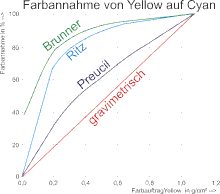Color acceptance
Ink acceptance refers to the acceptance of a printing ink (2) on a previously printed printing ink (1) in wet-on-wet printing . The ink acceptance behavior (FA) relates to solid tone densities (D). All color densities are measured with the color filter of the second color.
Calculation method
= Secondary density of printing ink (1), = density of printing ink (2) and = density of overprint
The literature gives three variants for calculating the ink acceptance from densitometric data:
Color acceptance according to Preucil
In practice, this method is the most common because of its simplicity. The Preucil formula is based on the model that the layers of paint are plane-parallel plates. It best reproduces the results of a gravimetric determination of the ink acceptance on laboratory prints.
Color acceptance according to A. Ritz
This method, known as the pearl factor, treats the second layer of paint like a grid, a pearly color. The formula is therefore similar to the Murray-Davies formula. Instead of the screen density there, the difference between the overprint and the density of the lower color is used and instead of the solid tone density in Murray-Davies' work, Ritz uses the density of the second color , where it is on the paper.
Color acceptance according to Brunner
System Brunner's formula is also based on a consideration like the Murray-Davies formula and compares the overprint (instead of its grid density ) with the sum of both individual measurements and instead of the solid density. This calculation formula is intended to describe the visual color shift due to the incomplete (second) color acceptance.
Naturally, all three calculation methods must lead to (roughly) different results for the color acceptance in percent because they are based on fundamentally different statements. In the diagram Comparison of the formulas for ink acceptance , they are compared with one another and compared with information from weighted laboratory proofs.
The ink acceptance in different printing processes
- Solvent-based printing inks largely dry while the machine is running from one printing unit to the next. At least they solidify in the short time interval to such an extent that the respective subsequent color hits a practically solid substrate and is assumed to have almost the same layer thickness as on the dry substrate. This corresponds to one hundred percent ink acceptance and applies to gravure printing as well as flexo and screen printing .
- The paste (paste-like, trowel applied) colors of the printing and offset printing solidify by ink setting the diluent in the printed material. This process is too slow for wet-on-wet printing. As soon as a second color meets a pre-printed first color in a subsequent work, this is still soft and there is a risk that the two will mix with one another and that the second will not be printed purely on the first.
- In letterpress and waterless offset printing , pure colors are printed, i.e. no emulgates . Here, their internal cohesion and their stickiness ( adhesion ) determine the transfer of color. The color pull (also called tack) of a color set is set in stages, the first at the highest and the following lower and lower. This means that the lower-speed color is always transferred to the higher-speed one. A set of process colors must always be printed in the specified order.
- Conventional offset printing with dampening solution works differently . The emulsification that has formed from ink and dampening solution to the rubber blanket is printed on paper, for example. The very low-viscosity dampening solution is absorbed into the substrate within a very short time , and the tack of the emulsifier suddenly jumps from the "wet tack" to the "dry tack" of the fresh ink. This is therefore sufficiently tightly connected to hold the next color emulgate in the subsequent work. Therefore, the printing sequence of the process colors can be swapped (washed around) in wet offset without causing catastrophic image errors.
Individual evidence
- ↑ Helmut Kipphan (Ed.): Handbuch der Printmedien. 1st edition. Springer, Heidelberg 2000, ISBN 3-540-66941-8 , p. 107.
- ↑ Helmut Kipphan (Ed.): Handbuch der Printmedien. 1st edition. Springer, Heidelberg 2000, ISBN 3-540-66941-8 , p. 108.
- ↑ Offsetpraxis, Druck & Medien Magazin 04/1993, p. 12, A. Ritz: Color shifts due to the pearl effect in wet-on-wet printing, ISSN 0030-0594
- ↑ System Brunner AG company publication : Brunner Eurostandard Cromalin_D.pdf , CH-6601 Locarno (Switzerland), p. 32










